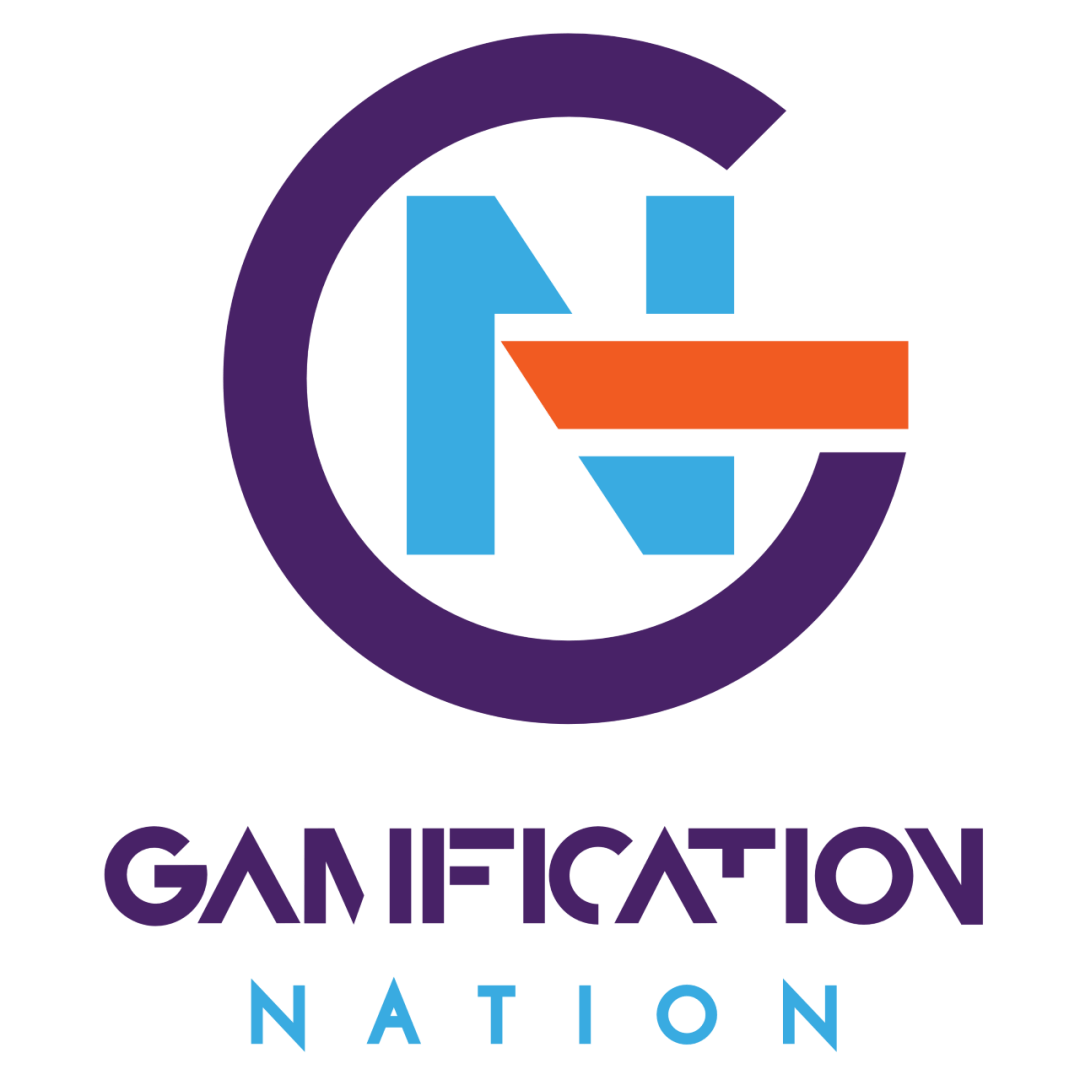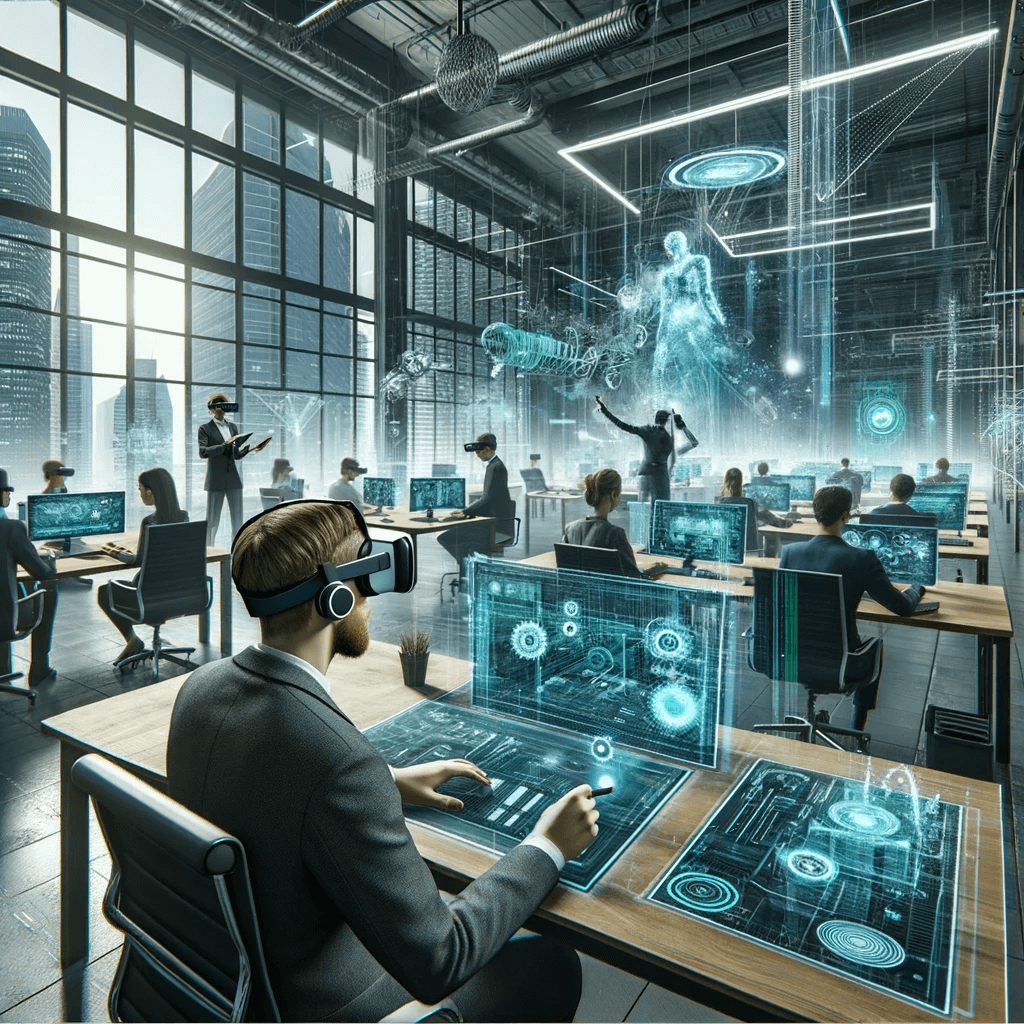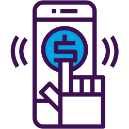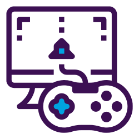Since 2017 I have been writing about trends in gamification and I didn’t want to stop this year, even If I also took a slightly different approach in presenting my thoughts. I tailored it more towards corporate decision-makers rather than general gamification enthusiasts, seen that our true audience are those of you actively working at implementing gamification for the company you work for. Hence here’s an in-depth look at the top trends for 2024, tailored for directors in the corporate sector, emphasising how they’ll impact various departments and highlighting anticipated technological developments.
1. Enhanced Generative AI in Gamification:
2023 saw the rise of generative AI in speeding up design processes for narratives and graphics. In 2024, expect more sophisticated AI integration, personalising user experiences, and generating dynamic content that adapts to individual learning and engagement styles, making gamification more effective and immersive. If you haven’t tried ChatGPT, Dall.e, Bard and others, it is high time that you do and learn to speak with machine learning prompts. You will at times think you are dumb and obvious, but I guess that is the nature of programming ‘garbage in/garbage out’. It will be a new skill that can speed up pretty much most work-related tasks.
Corporate Impact: The impact on corporates will be profound, especially in HR and Marketing departments. HR can use AI-driven gamification for personalised learning and development, career pathing, and employee engagement. Marketing can leverage it to create customised customer journeys and interactive campaigns. Enhanced AI will enable real-time feedback and adjustments, optimising user experience and outcomes. Always remember to fact-check though, AI is known to have rather hilarious brainfarts or original nonsense to be more politically correct.
2. Ethical AI and Responsible Gaming / gamification:
With the increasing use of AI, ethical considerations will become paramount. Companies will adopt transparent practices ensuring AI in gamification respects privacy, offers unbiased content, and promotes healthy, responsible gaming habits. The two belong together, ethics in gamification and ethics in AI are two close friends and neighbours. Both are powerful in reach and impact and both can be used to do massive harm from manipulation to stealing and copyright infringements. Like with all great innovation, put it in the wrong hands and you can have a less desirable impact. Even those with the right ethical intentions may still occasionally get it wrong.
Corporate Impact: Corporate Governance and HR departments will be at the forefront. Ethical AI will necessitate transparent policies and practices, ensuring fairness and privacy. It’s essential for maintaining brand reputation and employee trust. Responsible gamification always were and will continue to be crucial in employee training and development, ensuring a healthy, engaged workforce. Always remember that when introducing a game mechanic, you also inadvertently introduce a game dynamic and those you want to be ethical and responsible as well as all the other values your company stands for.
3. Metaverse Integration:
The blending of virtual and real life through metaverse platforms will continue to grow. Corporate training, team building, and marketing in gamified virtual environments will provide immersive experiences, improving engagement and retention. Even if Meta shelved its metaverse, we do see game environments such as Roblox, Fortnite, and others take up that space as well as the many spatial collaborative environments. Our own Mydigitaloffice.io is an example of this. With Microsoft taking over Activision Blizzard I expect to see a metaverse hovering on their horizon or at least they will own all the tech to do it with and the ready market in the corporate sector.
Corporate Impact: Operations, HR, and Strategy will be heavily impacted. The Metaverse offers a revolutionary platform for collaborative work environments, training simulations, and customer engagement. It will transform remote work, team collaboration, and experiential marketing. Remote and hybrid work is here to stay, and younger employees make that a point of choice for their future employers. To stay attractive, it is important to pay attention to this even if in hype terminology this may be going through a depression.
4. Sustainable Gamification:
Gamification strategies focusing on promoting sustainability and climate awareness will become more prevalent. Companies will use game mechanics to encourage eco-friendly practices and corporate social responsibility. I mentioned it last year and I think here is where gamification can impact for good with challenges and quests that make a difference. I expect more apps and platforms in this space to make sustainability a fun as well as transparent experience, where actions are measurable and trackable.
Corporate Impact: CSR (Corporate Social Responsibility) and possibly some Marketing departments will lead this trend, using game mechanics to encourage eco-friendly practices among employees and customers. Companies can use it to showcase their commitment to the environment and social responsibility, enhancing brand image and employee morale. We also see B corporations popping up in all fields, which effectively subscribe to a sustainable action strategy and live by it. Maybe the b-corp process should be gamified and indexed for share value and let’s then see how quick everyone will shift their focus on sustainability.
5. Blockchain and Secure Tokenisation:
Blockchain technology was mentioned in earlier years, and it will provide secure, transparent mechanisms for rewarding and tracking achievements. Expect to see tokenised rewards that can be traded or redeemed, adding a tangible value to gamified outcomes. So far gaming still pulls this trend and a bit of fintech. It has had a lot of bad reps because of its environmental impact and the big scams based on a combination of greed and naivety, anyone with some grounding in economics and in the gaming space world economy design could see that. Unfortunately, those voices were drowned out by the great innovation boomboxes. In any case, time is telling the real story. Either way, I believe the underlying technology has value if the rewards of tokens also carry value through the eyes of the recipient (and not the creator necessarily).
Corporate Impact: In my view, Marketing, HR and Learning would be the biggest beneficiaries of tokenised rewards adding a tangible value to gamified outcomes, but in reality, it is probably still Fintech and niche IT that will use it. Secure tokenisation offers a way to reward and track employee and customer engagement transparently, revolutionising incentive systems. It has a place in loyalty schemes, learning achievements, work and productivity achievements, attendance, etc. All of those may be considered soft impact, but when you delve under the surface, they also carry actual hard and tangible numbers. Saying that the same can be achieved without blockchain technology but it may be less transparent.
6. Increased Personalisation through Data Analytics:
Data analytics will drive hyper-personalised experiences. By understanding user behaviour and preferences, gamification can be tailored to increase motivation and effectiveness, offering a unique journey for each user. In my view, this is the biggest driver for gamification, and it ought to be the biggest ROI, but I am not sure all gamified systems are built with analytics in mind even though the game engagement tracking is totally possible.
Corporate Impact: Marketing, Sales, and HR will benefit significantly, tailoring the gamified experience to individual needs and preferences, enhancing engagement and effectiveness. Data-driven personalisation allows these departments to tailor experiences, offers, and learning paths to individual needs and preferences, increasing effectiveness and satisfaction. I also think data analysis and its interpretation should be a function in each of these corporate teams. We have more access than ever to rich data, I don’t believe a generalist will have the expertise to draw all the insights, AI can help but contextually and situational relevance is still better through human eyes.
7. Extended Reality (XR) Experiences:
The use of augmented, virtual, and mixed reality has been on my list for year, and I still consider it innovative enough to stay here. It has and will create more engaging and realistic gamification environments. These technologies will be used for training simulations, interactive meetings, and creating collaborative spaces that mimic real-life interactions. As most of our readers know, I have always favoured AR and XR over VR due to the headsets and the closing off from real life. I continue to do so because it can overlay digital information onto the real world, enhancing the user’s environment and providing a more engaging way to learn and explore.
I have high hopes for some developments that are set to come from Apple this year or maybe it remains Nvidia who keeps driving this change. In any case, in the AR field, we have seen some consolidation of platforms and more fun use cases. In VR the main protagonists remain in search of appeal outside of where they have already proven value such as simulation training in sectors where the reality of life or death or emotional psychological impact are high such as defence, health, and soft skills.
Corporate Impact: Operations, HR, and Training departments will be transformed, providing lifelike interactions, and enhancing the effectiveness of corporate activities. XR offers immersive experiences for training, simulations, and meetings, redefining remote work, onboarding, and continuous learning. Marketing experiences and try before you buy style AR and VR is on the rise in fashion, interior design, and tourism, potentially creating an additional category of virtual tourism that wasn’t there before.
8. Gamification for Wellbeing:
With a focus on mental health and wellbeing, gamification has been and will continue to be employed to encourage healthy habits, stress management, and work-life balance. Expect apps and platforms offering gamified wellness challenges and mindfulness exercises. With a recession comes additional pressure and I think these tools will offer a distinct advantage when offered to employees.
Corporate Impact: HR and Wellbeing initiatives will be central to this trend, making it a part of the corporate culture and improving overall productivity and satisfaction. Gamified wellness programs can lead to a healthier, happier, and more productive workforce. This can include challenges, rewards, and competitions related to physical activity, mental health, and other aspects of wellness.
Some of our earliest work was in this space and although the focus of the campaign was on wellbeing and beating the January blues, the knock-on benefits on productivity and communication were significant.
9. Voice-Enabled Gamification:
I said it last year and I will say it again, I believe voice assisted gamification through systems like Alexa, Siri, Bots, browsers extensions are only going to grow and should not be overlooked. The option of some AI tools is to give voice feedback, which is what will drive the uptake in this technology. Gamification will incorporate voice commands and feedback, offering a more accessible and intuitive way for users to interact with gamified systems. Bots that coach and keep people on track are being rolled out in many applications. When we look at what people are creating with their ChatGPT’s we see a trend of this nature with all kinds of helper bots powered by AI appear too.
Corporate Impact: Customer Service, Marketing, and Operations will find this particularly useful, making interactions more intuitive and accessible, improving user engagement and satisfaction. Voice-enabled technology can simplify tasks and make technology more approachable for a wider audience. With automation of all business processes, I believe the nudge towards completing a process and progress tracking with milestone achievements is the base for much process related gamification. It means that those in product design need to be aware of the trigger moments and emotional journeys of their users to stimulate completion and progress.
10. Adaptive Learning Platforms:
Adaptive platforms are standard course in games, but in a corporate application I believe it will be AI that will assist gamified learning platforms to introduce adaptive learning. It takes a lot of instructional designer time and effort to be able to design pathways for multiple abilities and knowledge levels, however generative AI can help you create this in seconds. Systems will use AI to adapt in real time to the user’s knowledge level, pace, and learning style. This will provide personalised learning paths that improve knowledge retention and make learning more efficient. We already see how learners interact with bots and help the bot adapt to their level of knowledge with additional questions.
Corporate Impact: Primarily impacting HR and Training departments, adaptive learning platforms revolutionise professional development and continuous learning. They provide personalised learning experiences, making training more efficient and effective, catering to individual learning styles and needs. Although I see the main use case of this technology in learning, I would also expect it to start showing up in operational and productivity focused applications. Even knowledge heavy parts of organisations such as marketing, research and HR would benefit from offering systems that adapt to the user. We all have different knowledge starting points and abilities.
11. Gamified Recruitment:
I still consider this a growth area, even if it has been around for probably close to a decade, we see more and more intelligent use of gamification with corporate branding at its core and with specific job titles in mind. Companies are using gamification elements in their recruitment processes to attract, engage, and assess candidates in a more interactive way. This can include anything from gamified skill assessments to virtual reality interviews. In our custom design work, we see this appear more and more frequently for roles that where a talent shortage exists or where the battle for the best talent is super-competitive.
Corporate Impact: HR departments can significantly improve their talent acquisition strategies. Gamified recruitment provides a more comprehensive view of a candidate’s capabilities and fit, leading to better hiring decisions and a more engaging candidate experience. In use case we have implemented, we have seen a significant increase of uptake and applications in comparison between gamified and non-gamified recruitment processes.
12. Real-Time Feedback and Analytics:
Gamification platforms are increasingly capable of providing real-time feedback and analytics. This gives users immediate insight into their performance and progress while providing companies with valuable data on user engagement and effectiveness. I would also still say that the power lies in identifying micro-trends over time. In any given organisation you will only have so much data and making sure you draw meaningful enough analytics also means you need to let an application run for at least a week or 2 to get any insight into trends.
Corporate Impact: For management in all departments, this means access to a wealth of actionable data. They can track progress, identify areas for improvement, and make informed decisions to enhance the effectiveness of their gamification strategies. A simple browser refresh tends to be all that is required to see the latest data and that for gamification is a key driver for engagement. We see it time and again on our quiz platform Playerence that the top scorers want to know they are still top dog instantly rather than in delay.
13. Emotional Engagement Through Storytelling:
I guess this trend is still not as widespread as I would like it to be, but more and more great examples are being shared online. We know that incorporating narrative elements into gamified systems creates higher emotional engagement and a more immersive experience. Stories can contextualize challenges and achievements, making the experience more meaningful for the user. I am not sure if it is corporate reticence or designer failure to encourage storytelling that is at the source of this slow-moving trend or potentially lack of know-how or adequate system.
Corporate Impact: Marketing and HR departments can leverage this to create more compelling campaigns and training programs. Emotional engagement leads to higher retention rates and a deeper connection to the company’s values and goals. I believe metaverse technology allows to go much deeper down this trend than most other options and that this may well be the tipping point for better storytelling. Those that get it right, have been getting it right for a long time.
14. Peer Recognition and Social Rewards:
Gamification platforms are increasingly incorporating social elements, such as peer recognition and rewards. This fosters a sense of community and encourages users to engage not just with the platform, but with each other. I also see some reverting to the lazy variety of points and leaderboards for any activity at all, which to me is a wasted opportunity. With more knowledgeable users this does get spotted and called out, but the platforms or community owners are slow to amend and drive change to their platform. I believe the platform owners should educate (or get educated) on how to encourage people so that quality and meaningful contributions are rewarded instead of quantity.
Corporate Impact: Peer recognition and social reward have the potential to enhance the company culture and employee engagement. Recognising and rewarding achievements publicly can lead to a more motivated and committed workforce. The potential for the reverse is also there when not implemented with insight into what matters and motivates your employees or community of followers.
15. Location-Based Gamification:
I added it a few years ago and with 5G becoming more widespread it will continue to increase as a trend. With the use of GPS, beacons, and other location technologies (or scannable QR or AR codes), some gamification strategies incorporate the user’s location into the experience. This can add a layer of context and relevance to tasks and challenges. I believe we will see more of this as the networks and access to them improve to more devices.
Corporate Impact: For marketing and sales this provides an opportunity to have geo-specific campaigns and deals. For companies with a mobile or field-based workforce, this can also be useful and impactful. It can enhance training, team-building, and operational tasks by making them more relevant to the user’s current context and location.
16. Behavioural Economics and Behavioural Psychology as replacement terms for Gamification:
Gamification as a buzzword has sort of lost its glossy image and roll in the new wording in terms of behavioural psychology and behavioural economics or even behavioural design. In effect, good gamification should have been using behavioural design from the get-go, but very few called it that. Incorporating principles from behavioural economics, like loss aversion and the endowment effect, can make gamification strategies more effective by tapping into how people are motivated and make decisions. In my view, gamification has always been more about the psychology and understanding of behaviour rather than simply applying game mechanics.
Corporate Impact: Marketing and Strategy departments can use these principles to influence customer and employee behaviour more effectively, leading to better outcomes in areas like sales, customer engagement, and employee performance. All teams in my view will benefit from understanding their users and what motivates them to deliver a better outcome for that same person. Just be aware that what this is called may have changed name.
17. Pull versus Push gamification:
With big changes ahead and in some browsers already implemented, privacy trumps over tracking. When it comes to gamification where tracking is essential to give appropriate and relevant nudges, this means it will have to be pull-based rather than push-based, meaning that people will have to be invited to play rather than enter a game without their explicit knowledge. We thank the EU and privacy regulations worldwide for this as well as some of the big technology firms making their browser already averse to tracking for advertising purposes. I have called this best practice for a long time, but for some, it will finally force them into compliance.
Corporate impact: In marketing, this will probably have the biggest impact, where push marketing strategies and personalisation will need to shift to pull or invitation-based strategies. All customer-facing teams especially customer service and sales may already have had to adapt and potentially faced questioning about how data is handled. One thing I would love to see more gamified is the training about these regulations as well as the transparency from big technology players of what they are now removing and pushing when they make changes to privacy and cookies. In my view generally speaking this it is a good trend, I like to be in control of my data and my companies’ data, I only wish the implementation would be simpler.
Conclusion
I think a lot of the trends are obvious and a cascade down from technology changes in general. When I look at what is being implemented in the corporate sector, then I would say the larger the organisation the slower the adoption rate of innovation. Equally, the more traditional the industry, the speed of adoption is even more snail pace level. Sometimes it requires a big risk or event to drive innovation. I hope that the pandemic taught us that lesson, but from what I am seeing it seems to not stick so well.
In 2024, I believe gamification is relevant and can shape the way corporates engage with employees, customers, and stakeholders. As these trends continue to evolve, they offer exciting opportunities for companies willing to innovate and adapt. The companies that effectively harness these trends will find themselves at the forefront of their industries, with a more engaged, motivated, and high-performing workforce.




